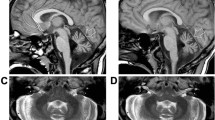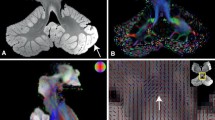Abstract
Focal lesions of brainstem, thalamus, and subcortical white matter may cause movement disorders that are clinically indistinguishable from cerebellar symptoms. It is suspected that ataxia in these cases is due to damage of efferent or afferent pathways of the cerebellum. However, the precise anatomical correlate often remains undefined. We used deterministic diffusion tensor magnetic resonance imaging (DTI) tractography to study the anatomical relationship between lesions causing ataxia and efferent cerebellar pathways. Study subjects were six male patients with focal lesions of different etiology (demyelination, hemorrhage, ischemia, neoplasm) outside the cerebellum. Five patients had cerebellar-like ataxia with prominent contralateral upper limb involvement. One patient with an almost midline mesencephalic lesion had a symmetrical ataxic syndrome. We used 3T MRI (Intera, Philips Medical Systems, Best, Netherlands) and DTI tractography (32 directions, StealthViz DTI, Medtronic Navigation, Louisville, USA) to delineate the dentato-rubro-thalamo-cortical tract (DRT). In all patients, tractography demonstrated focal lesions affecting the DRT in different locations. We conclude that in vivo mapping of cerebral pathways using DTI tractography in patients with focal extracerebellar brain lesions may provide direct evidence of circumscribed damage to the DRT, causing unilateral cerebellar-like ataxia. Also, a unilateral mesencephalic lesion at the level of the crossing of the DRT may cause bilateral ataxia.






Similar content being viewed by others
References
Marx JJ, Iannetti GD, Thömke F, Fitzek S, Galeotti F, Truini A, Stoeter P, Dieterich M, Hopf HC, Cruccu G (2008) Topodiagnostic implications of hemiataxia: an MRI-based brainstem mapping analysis. Neuroimage 39(4):1625–1632 (Epub 2007 Oct 16)
Mossuto-Agatiello L (2006) Caudal paramedian midbrain syndrome. Neurology 66(11):1668–1671
Krespi Y, Aykutlu E, Coban O, Tunçay R, Bahar S (2001) Internuclear ophthalmoplegia and cerebellar ataxia: report of one case. Cerebrovasc Dis 12(4):346–348
Luijckx GJ, Boiten J, Lodder J, Heuts-van Raak L, Wilmink J (1994) Isolated hemiataxia after supratentorial brain infarction. J Neurol Neurosurg Psychiatry 57(6):742–744
Mori S, Kaufmann WE, Davatzikos C, Stieltjes B, Amodei L, Fredericksen K, Pearlson GD, Melhem ER, Solaiyappan M, Raymond GV, Moser HW, van Zijl PC (2002) Imaging cortical association tracts in the human brain using diffusion-tensor-based axonal tracking. Magn Reson Med 47:215–223
Basser PJ, Mattiello J, LeBihan D (1994) MR diffusion tensor spectroscopy and imaging. Biophys J 66(1):259–267
Behrens TE, Johansen-Berg H, Woolrich MW, Smith SM, Wheeler-Kingshott CA, Boulby PA et al (2003) Non-invasive mapping of connections between human thalamus and cortex using diffusion imaging. Nat Neurosci 6:750–757
Coenen VA, Mädler B, Schiffbauer H, Urbach H, Allert N (2011) Individual fiber anatomy of the subthalamic region revealed with diffusion tensor imaging: a concept to identify the deep brain stimulation target for tremor suppression. Neurosurgery 68(4):1069–1075 (discussion 1075–6)
Weyer A, Abele M, Schmitz-Hübsch T, Schoch B, Frings M, Timmann D, Klockgether T (2007) Reliability and validity of the scale for the assessment and rating of ataxia: a study in 64 ataxia patients. Mov Disord 22(11):1633–1637
Deuschl G, Bain P, Brin M (1998) Consensus statement of the Movement Disorder Society on Tremor. Ad Hoc Scientific Committee. Mov Disord 13(Suppl 3):2–23
Yousry TA, Schmid UD, Alkadhi H, Schmidt D, Peraud A, Buettner A, Winkler P (1997) Localization of the motor hand area to a knob on the precentral gyrus. A new landmark. Brain 120(Pt 1):141–157
Mori S, Crain BJ, Chacko VP, van Zijl PC (1999) Three-dimensional tracking of axonal projections in the brain by magnetic resonance imaging. Ann Neurol 45:265–269
Kreher BW, Mader I, Kiselev VG (2008) Gibbs tracking: a novel approach for the reconstruction of neuronal pathways. Magn Reson Med 60(4):953–963
Conflicts of interest
On behalf of all authors the corresponding author states that there is no conflict of interest.
Ethical standard
All patients gave written consent for the MRI and the study was performed in accordance with the ethical standards laid down in the 1964 Declaration of Helsinki and its later amendments.
Author information
Authors and Affiliations
Corresponding author
Electronic supplementary material
Below is the link to the electronic supplementary material.
415_2014_7503_MOESM1_ESM.png
Supplementary material 1 (PNG 288 kb) Patient 5 with multiple sclerosis with demyelinating lesions interrupting the DRT causing contralateral postural and intention tremor as well as ataxia. This patient was successfully treated with Deep Brain Stimulation (DBS el.) also affecting the DRT. PT = pyramidal tract, DRT = dentate-rubro-thalamo-cortical tract
Rights and permissions
About this article
Cite this article
Marek, M., Paus, S., Allert, N. et al. Ataxia and tremor due to lesions involving cerebellar projection pathways: a DTI tractographic study in six patients. J Neurol 262, 54–58 (2015). https://doi.org/10.1007/s00415-014-7503-8
Received:
Revised:
Accepted:
Published:
Issue Date:
DOI: https://doi.org/10.1007/s00415-014-7503-8




